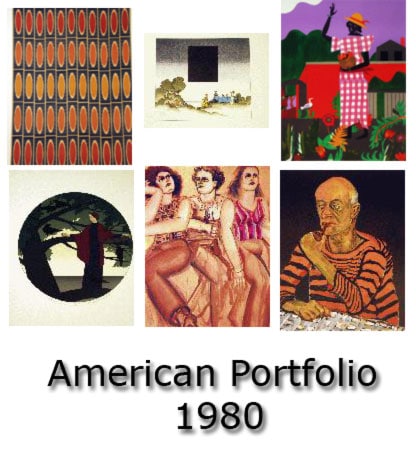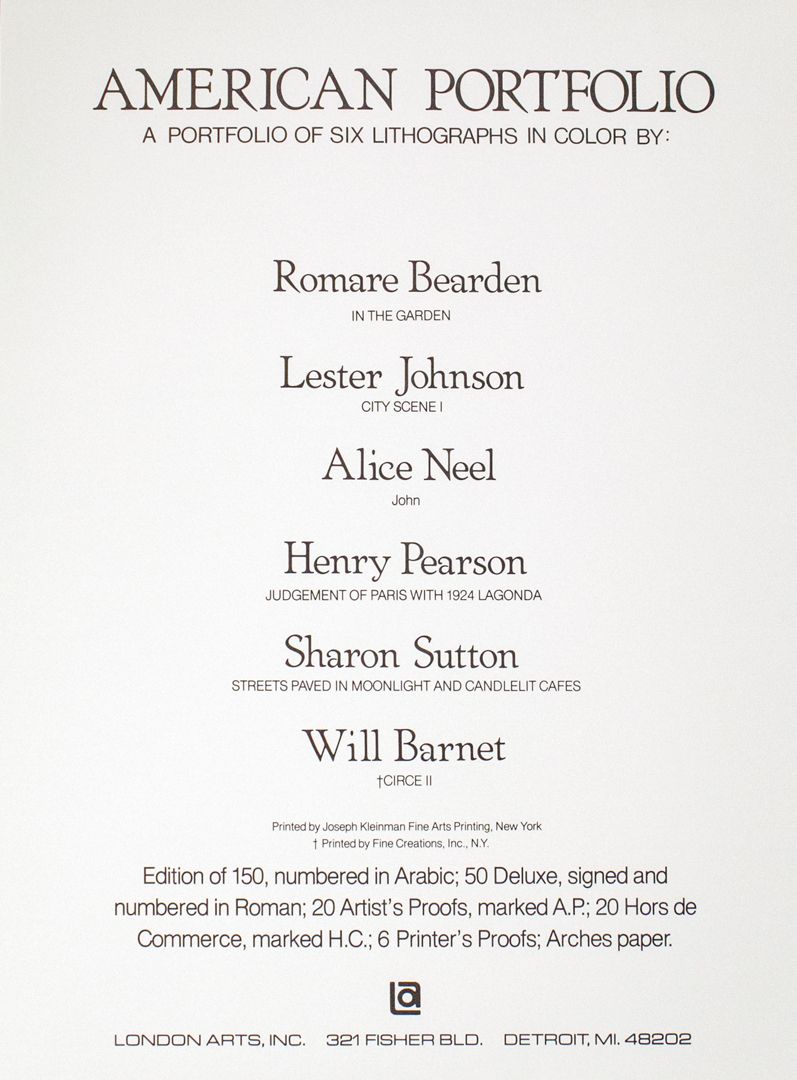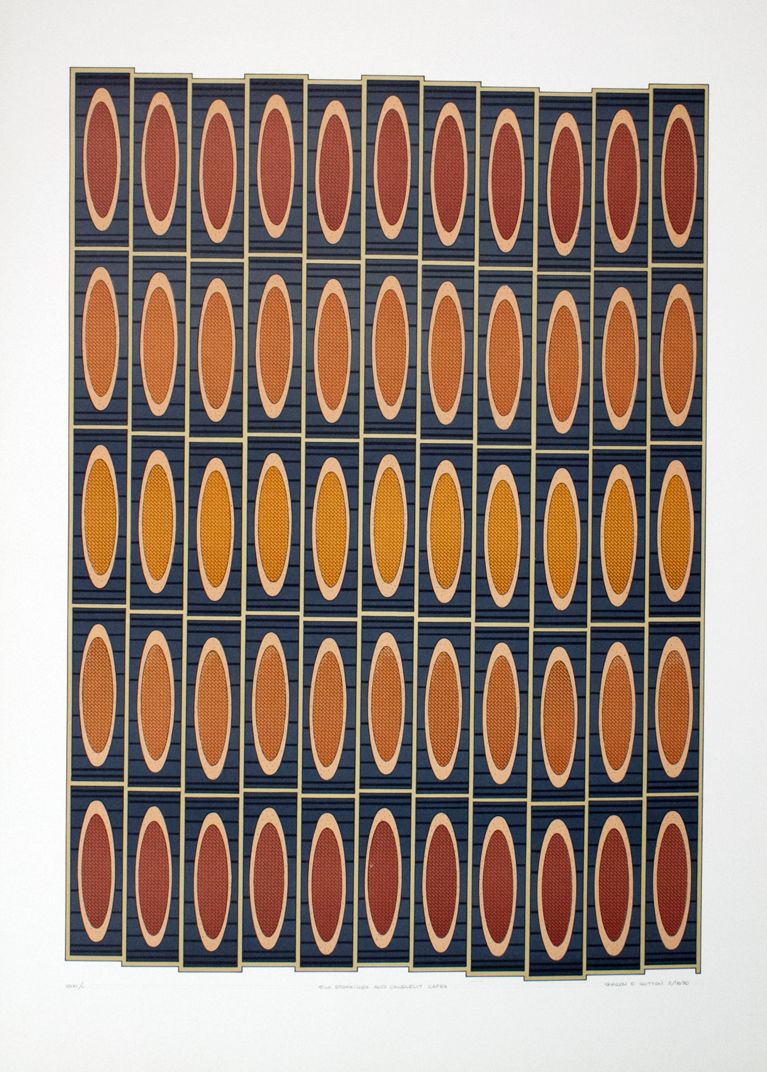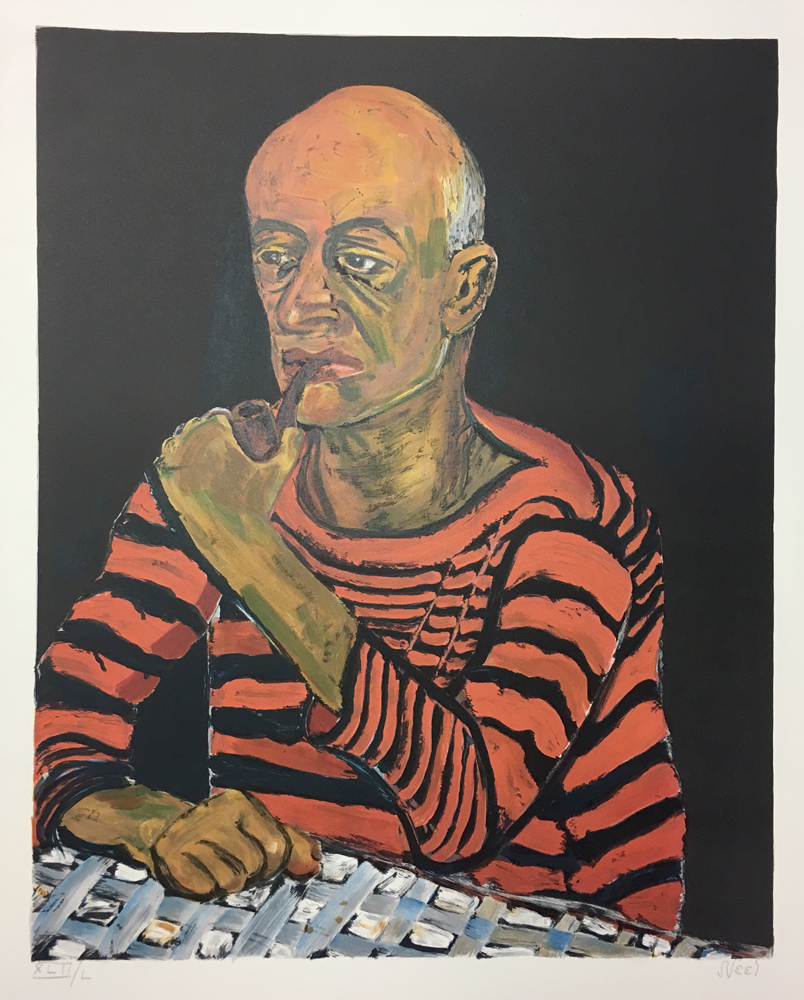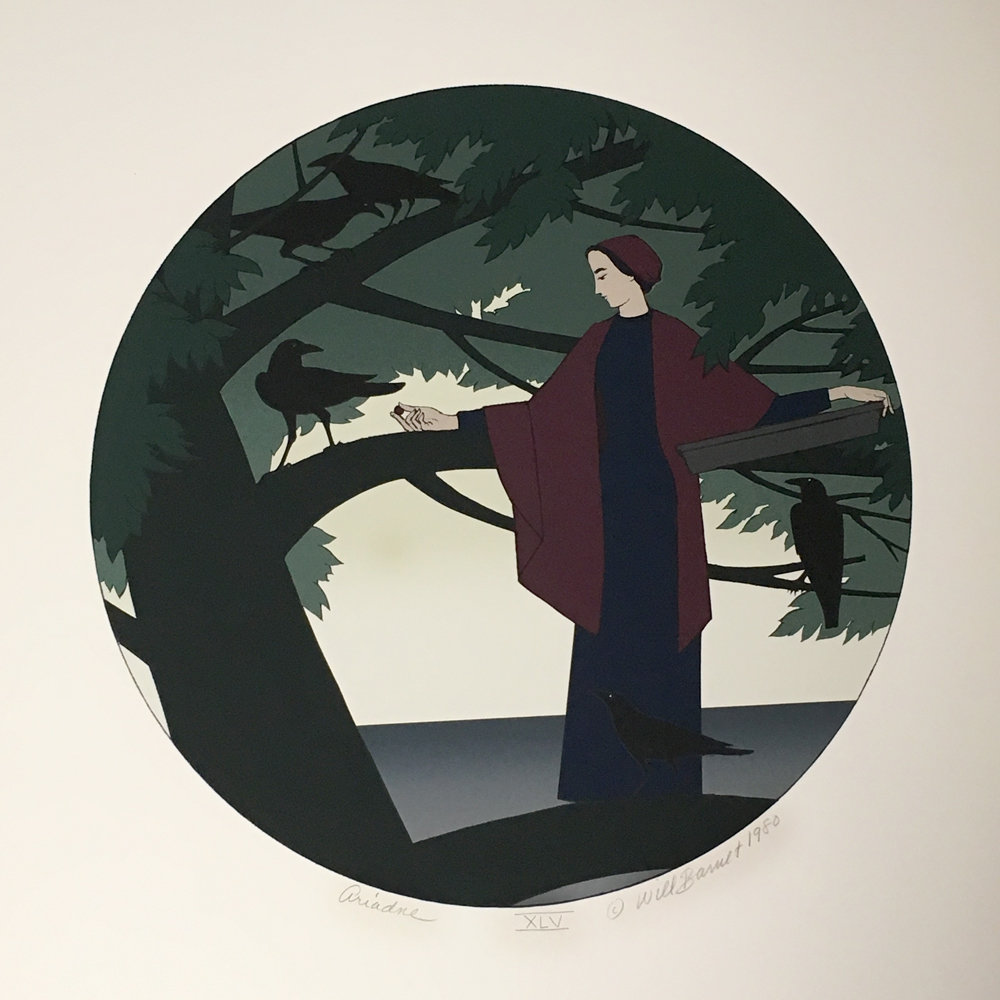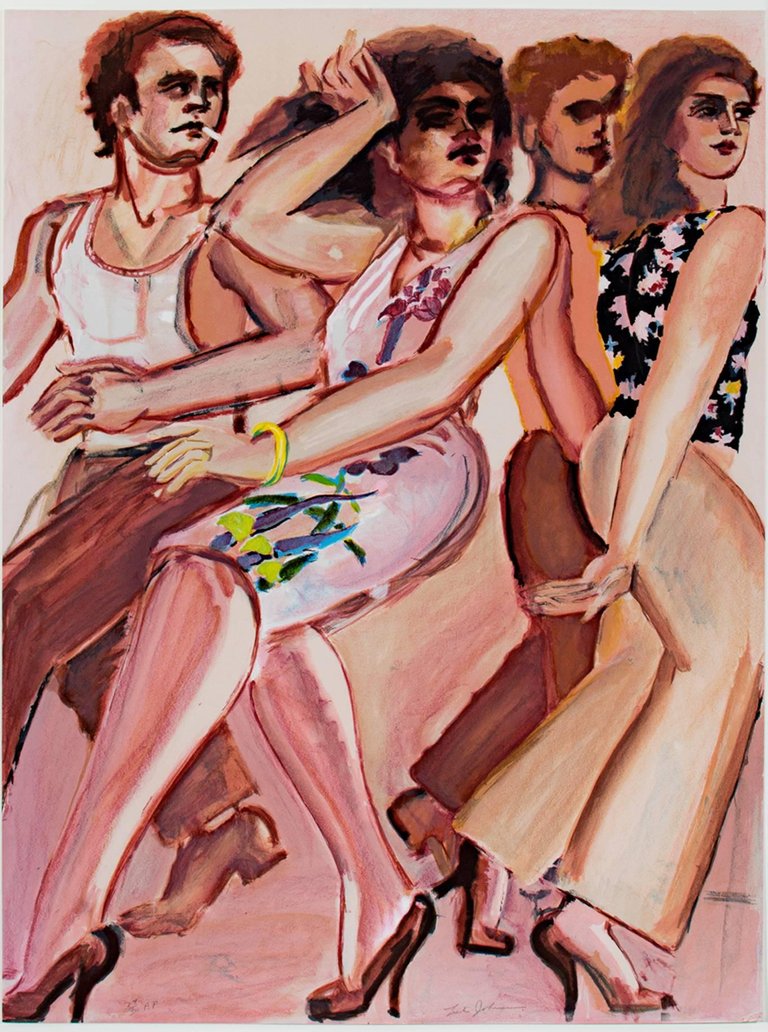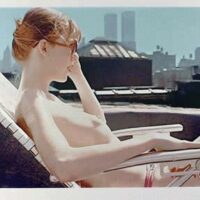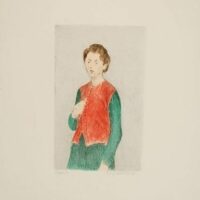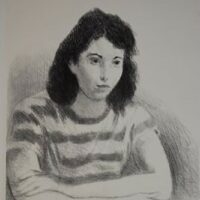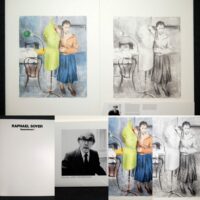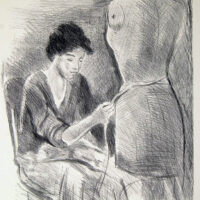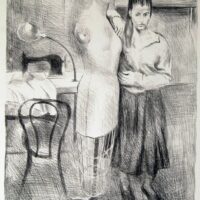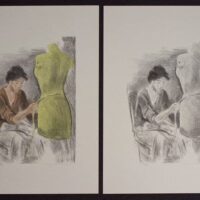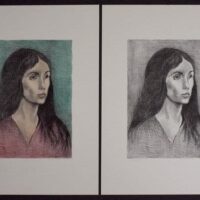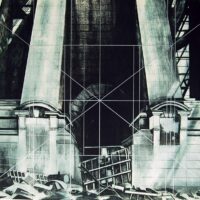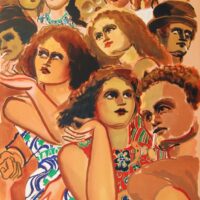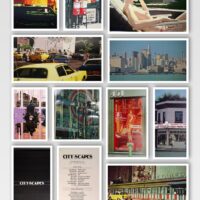Description
The six lithographs in this American Portfolio depict seemingly happy states of American life, whether the dream of solitude, nostalgia for past decades or serenity in the present, the shopping for beauty, the joys of country life or the excitement of patterns of reflected light in a city, the dream of companion-ship or the assertion of self, or even the rejection of conventional modes of beauty or acceptance — they are all ordinary simple ideals and contem-porary values. But what makes these particular lithographs extraordinary? What about them sharpens our vision? And how do these artists make us see ourselves critically? For things are never merely what they seem, and beneath the layer of apparent criticism or self-satisfaction lies the power to move and change.
These mature artists accept the facts of life and yet transform them into shapes of beauty, show them as vehicles of joy or of awe, revealing their wonder and their true ethical importance, and build out of them a world more real than reality itself, and of loftier and more noble import.
They are all abstractions, whether they include figures or not — through simplification of form or color, and the reduction of the three-dimensional world to a two-dimensional surface — so the important thing to consider is the imagery of the print and the artist’s use of the grammar of imagery to con-vey meaning. In every case, the subject matter — discs of color, human figures, trees or cars — is tied very closely to the artist’s style. A consistent image is produced by the union of image and grammar, and the communication of art consists not only in this link, but in the resonance and complexity of the result.
An important collection of limited edition prints by 6 notable American artists;
Romare Bearden, Lester Johnson, Alice Neel, Henry Pearson, Sharon Sutton, and Will Barnet
An important collection of limited edition prints by 6 notable American artists;
Romare Bearden, Lester Johnson, Alice Neel, Henry Pearson, Sharon Sutton, and Will Barnet
Available as a complete portfolio collection with matching edition numbers and portfolio cover.
Published by London Arts, Inc 1980
AMERICAN PORTFOLIO
INTRODUCTION
by
KARL LUNDE
The six lithographs in this American Portfolio depict seemingly happy states of American life, whether the dream of solitude, nostalgia for past decades or serenity in the present, the shopping for beauty, the joys of country life or the excitement of patterns of reflected light in a city, the dream of companion-ship or the assertion of self, or even the rejection of conventional modes of beauty or acceptance — they are all ordinary simple ideals and contem-porary values. But what makes these particular lithographs extraordinary? What about them sharpens our vision? And how do these artists make us see ourselves critically? For things are never merely what they seem, and beneath the layer of apparent criticism or self-satisfaction lies the power to move and change.
These mature artists accept the facts of life and yet transform them into shapes of beauty, show them as vehicles of joy or of awe, revealing their wonder and their true ethical importance, and build out of them a world more real than reality itself, and of loftier and more noble import.
They are all abstractions, whether they include figures or not — through simplification of form or color, and the reduction of the three-dimensional world to a two-dimensional surface — so the important thing to consider is the imagery of the print and the artist’s use of the grammar of imagery to con-vey meaning. In every case, the subject matter — discs of color, human figures, trees or cars — is tied very closely to the artist’s style. A consistent image is produced by the union of image and grammar, and the communication of art consists not only in this link, but in the resonance and complexity of the result.
In a time of international and personal insecurities, it is not improper to consider works of art — their apparent realism, their most obvious meanings as defined by accepted associations — as something more contemplative than the activities of the day, and to search for what they can teach us about our present state and destinies and how we can find happiness in the context of our routine lives. Art, in its deepest sense, is organization out of chaos —which is meaning — and these modern works attempt to fit the pieces of our culture together. So, in a way, this portfolio shows six different ways to create order out of chaos, and to find beauty through acceptance of a world that seems to be frequently hostile and baffling.
These should not be considered as works of art expressive through format or content alone; they should instead be considered from the point of view of the effect that they finally produce. Explaining the work of art — either in the sense of identification of subject matter, or of purely formal analysis (com-position, light, color, line, movement) — can reduce art to the obvious. One should rather seek to deepen the mystery and the energy, to raise around it, and around the artists, that mist of wonder which is essential to both the creative person and his admirers. Mystery is a necessary ingredient of art.
As we consider these, we learn to respect the Henry Pearson as much as the Lester Johnson, the Sharon Sutton as much as the Will Barnet, the Romare Bearden as much as the Alice Neel. To arrive at a deeper enjoyment and understanding of art, we should come to understand that evaluation has no place in relationship to art, evaluation in the sense of good or bad, that some statements are more worthy than others, modern better than ancient or Renaissance better than Baroque. But, instead, that acceptance of the premise of the work of art is a necessary precondition for understanding, and that there is no mood, no emotion, no belief which should be foreign to man’s experience or sympathy. Therefore, these works, like all works of art, should be viewed when one has time to contemplate, and the portfolio is the perfect format for doing so — because you must reserve a time to do it, to sit down, to open it, to enjoy a tactile and a visual experience. This is different from experiencing the framed picture which can be walked by, eventually as un-noticed as overly familiar furniture,
Sharon Sutton’s Streets Paved in Moonlight and Candle Lit Cafes, elegantly and precisely executed in the colors of earth and sidewalks, contains the• fleeting, slippery images produced by moonlight and rain, flickering candles and crowded compressed spaces, that can cause one to slip or bump. The one thing in a painting or print that is usually stable is the frame, but in this case it shifts and slips like dislodged masonry. The distortion of the ovals that turn to circles as one moves to left or right before her lithograph, the gold reflected surfaces and shifting frame, the concave backgrounds and flat patterned discs all reconfirm the instability and insecurity of the perception of material objects, the illusion of light and movement. In this regard, it is a spiritual painting, declaring the reality of intangibles and the omnipresence of energy and light. She is a dreamer who finds her way by moonlight.
In her work there is a maximum sameness in each cartouche of the design, with a maximum difference between the cartouches through place-ment, color andtone. This expresses, with the precision of mathematics, one of the most profound underlying principles of life: that everything is related to everything else, and everything is different from everything else.
While Henry Pearson’s witty and meticulous Judgment of Parts with 1924 Lagonda seems to be a light-hearted mock.heroic illustration in story-book pastels, there is an ominous black heavy block hovering in the sky while Paris as a shepherd makes up his mind, evaluating cars and women. In an age when aesthetic values are cultivated by advertisements for automobiles, how can the bewildered youth choose his favorite woman? The car may not only be the most beautiful object in his life, it may also substitute for power and sex and ultimate destruction. The big black block in the sky is the hole without an end, an image of love and death. The women look off past it across an endless ocean, They are clothed in forms of purity — pure yellow, pure lavender, pure white — dressed in gossamer, ethereal as angels (or goddesses), uncon-cerned as to the outcome of Paris’ decision. It is almost as if the threatening block, this thing so unsteadily placed, watching this scene, commands Paris’ choice, just as the destruction of Troy was predetermined through the abduc-tion of Helen, Aphrodite’s gift to Paris, Paris will again choose love rather than wisdom or worldly power, but here the lure is the irresistible car, or perhaps an irresistible way of life.
This American Portfolio contains another idyllic scene, Romare Bearden’s In the Garden. The tall, graceful woman greeting the birds and plants is gathering flowers in a basket. Upright and expansive, she is determinedly looking for beauty a garden with barnyard fowl and prickly leaves. This is a picture of jagged nature in a graceful mood. At first the action seems simple, natural, spontaneous, gentle and joyful, but the forms, are harsh, hard, man-made and aggressive, and the colors are chemical, dazzling and desperately cheerful. The rigid geometry of the lithograph and the puppet-like gestures and cut-out face of the woman make her good humor seem mechanical and automatic. Even the pattern of her dress refuses to conform to the contours of her body and maintains its own rigid integrity. i-low can one be beautiful, graceful and exuberant in a world made of such uncompromising elements? It is testimony to the dignity and spirit of this woman that the effort against odds is the beauty of her life.
It is also testimony to the resilience of this artist with his collagist approach to art that he can gather the rejected scraps of mass culture and arrange them into a work of beauty.
Is Lester Johnson’s City Scene I as prosaic as it seems? Self-assured, a trio dressed in clothes which emphasize their physical nature rather than disguise it, attempt to relax in self-contained musing poses as awkward to maintain as yoga positions — positions that, however, emphasize their hips, the tightness of their clothes. Even though their legs and arms are intertwined and almost interchangeable, they all look at the world in different directions, askance through heavy eyelashes. But they seem content with physical con-tact and mental isolation. However, the freedom of their association is contradicted by their tightly closed, withholding lips. They disregard, are even contemptuous of, physical appearance in their almost classless uniform clothing and matted hair. Their accidental relations and casualness are echoed in muddy color and dripping paint. As a comment on the art of the past, Leonardo da Vinci and the Statue of Liberty are reduced to T-shirt decals and as advertisement for an Italian restaurant.
Classical as Greek sculptures crowded into a metope, the figures are monumental, but uncomfortable, ego-inflated, narcissistic, inflated as balloons and squeezed against the limits of the image. Although accepting and uncritical of the subjects of his lithograph, this artist is critical of art and the academic rules of art in many ways: he avoids finish and perfection and elevating subject matter, but he does express everything through the figure. He is not interested in being pleasing in traditional ways; he, like, the subjects of this lithograph, asks for new criteria.
Alice Neel’s John sits like a well-known photograph of Picasso, with all his familiar attributes: the bald head, the striped sailor’s shirt and the pipe — a pseudo-Bohemian. He is all Chiaroscuro, light and dark, red and black, nothing in-between.
He is, however, a complex person who doesn’t have a clear image of himself and represents many of the contradictions of contemporary life: he is old but dresses young and he is macho with ineffectual weak arms but a firm grip on his pipe. His face is asymmetrical with one eye ascending and one eye descending, a series of contradictions, Both hands are tightly clenched and his shirt binds him like a mummy-wrapping. He is inward and introspective, but the rounded forms of his body are expansive. He represents contem-porary man at an awkward age, in the middle of the journey.
His problems are ours, our crisis of identity through clichés. The artist has chosen to show a man in a pose of manliness (a thoughtful pipe-smoker) and artiness (Picasso), a modern man who is asked to be all things to all people.
And yet. . after all these thoughts have occurred, through the magic of Alice Neel’s perception one sees the man — through the disguises, through the poses — as one of us. And at that moment of clarity comes warmth and compassion. After all, who made him wish to please us?
In the print Circe II by Will Barnet the subject is the most renowned sorceress of Greek mythology, best known for turning men into animals and birds; a reference to the power of woman to bewitch men by arousing their animal emotions. In this print, a fragile peaceful woman is in a contradictory element of destructive and protective qualities, the bringer of life and death. At home with birds in the tree, her face turned from us and thus unreadable, eternal and patient, waiting like a spider in a web of branches, she is a strange combination of the destructive and creative elements of woman.
As the creator-destroyer with the crow — the blackest bird, a silhouette of darkness, of the unknowable and of death — she is also in a circle which removes her from the context of the four directions. She is a vision, endless like the circle, coming back on itself: thesis, antithesis and synthesis.
She sits in a black tree in an intimate relationship with her black birds; presumably they are in her power. So she is at ease with the mysteries and even in control as she looks out waiting to the sea. She is the culmination of other images that Will Barnet has created; the woman with a cat (an animal that also knows the mysteries of the afterlife), the woman with an apple like Eve, the woman looking out to sea on her widow’s-walk, staring into the void, and the woman reading, blowing bubbles, or playing chess. Will Barnet creates moments of significance out of pastimes, Circe’s delicate balance in this tree reflects her precarious emotional position, but she is on her own island, comfortable and harmonious in her chosen setting.
What do these images have in common, and how do they reflect the opening of the decade of the 1980’s?
They all raise questions of man’s future, of the imminent destruction of peace and beauty, of the destruction of personality and a desire to retreat to nature. They capture life in its unsure, or transient moments and they all have forebodings of destruction. But in their concern for timeless values and the sense of continuity and communion that the appreciation of all of art’s forms brings, they are not warnings nor are they condemnations, since man has always puzzled over meaning and existence. Instead, they try to accept, to adjust to man’s state and to find beauty in it. From the most abstract to the most figurative they are all optimistic in their humanism. Searching for beauty and nobility, they stimulate our imaginations and show us the unity of the human mind in the variety of its forms.
DR. KARL LUNDE is the author of monographs on the contemporary American artists Isabel Bishop and Richard Anuszkiewicz. published by Harry N. Abrams, Inc., and the author of a dissertation on Johan Christian Dalil, one of the first 19th century Norwegian landscape painters. Dr. Lunde is a specialist in European Neo-Classic and Romantic Art, who for the past decade has been Professor of Art History at The William Paterson College of New Jersey. He was formerly on the staff of the Art History Department of Columbia University, New York. where he received his Ph.D., and he has also written many articles on contemporary prints and drawings.
